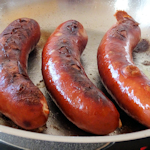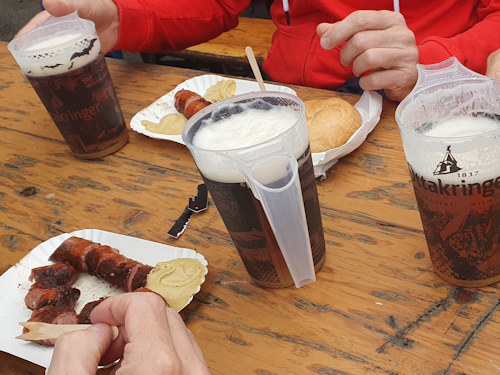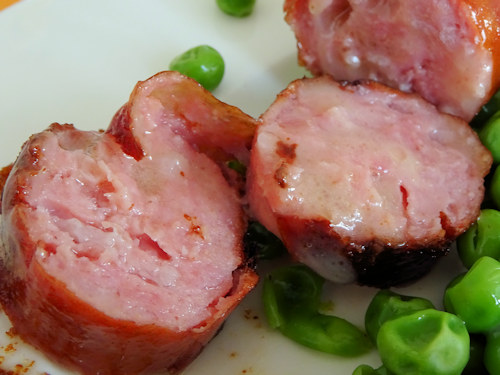
You may associate Vienna with delicate cakes and Imperial dining. But the old stalwart of Viennese cuisine and a reliable solution to late-evening pangs of hunger is the humble and tasty fat bomb known as the Käsekrainer…
- Cheese-filled parboiled sausage
- Take care when slicing
- See also:
What is a Käsekrainer?

(Beer and Käsekrainer before the football game)
To answer the question in the headline: a large, thick parboiled sausage filled with small chunks of cheese (German: Käse) to which the Käsekrainer owes its name.
You typically fry or grill it, which melts the cheese to create the distinctive texture and taste. Escaping cheese often forms a crust across the outside during this process.
Sausage stands usually serve the Käsekrainer with a white bread roll or a slice of dark bread, plus mustard and/or ketchup.
There’s something strangely captivating about slicing into one of these delights and seeing hot, melted cheese ooze or squirt out.
In fact, if you’re not careful, a sufficiently-distressed Käsekrainer can propel hot fat huge distances, necessitating the wearing of protective goggles and clothes normally seen in radiation labs. Which is why some places cut it up for you before serving.

(Not likely to be confused with nouvelle cuisine)
You may find locals describing this traditional sausage variety as an Eitrige, from the German word “eitrig” which means ulcerous or pus-filled. A rather unpleasant description, but understandable when you see cheese seeping out of a sliced Käsekrainer.
(Debate rages as to whether this term is a real Viennese one or simply a devious invention to impress/scare tourists.)
The Käsekrainer enjoys particular popularity around football stadiums on matchdays, where it often appears inserted into a small baguette-like roll as a kind of hot dog.
This sausage holds a special place in my heart (presumably now blocked by cholesterol), as it was the first one I ate in Vienna. It continued to maintain a deep hold on my affections until I went vegetarian and will be my first meal if I ever reverse that decision.
Unfortunately, on my arrival in Austria, I misread the signs and called the Käsekrainer a Kaiserkrainer, which sounded entirely plausible given Vienna’s Imperial history (Kaiser is the German word for emperor). Franz Joseph, for example, was known for his love of plain Viennese food.
For the next fifteen years I kept ordering a Kaiserkrainer, to be met with the inquiry, “a Käsekrainer?” I always assumed this was local dialect for Kaiserkrainer and they were just checking whether they’d heard me properly. Fifteen. Years.

(Sliced Käsekrainer revealing the melted cheese texture within: usually served with bread, mustard and ketchup, rather than peas!)
A little bit of history
The Käsekrainer once almost caused a diplomatic incident between Slovenia and Austria.
The Slovenians persuaded the EU to give the Kranjska klobasa (German: Krainer Wurst; English: Carniolan sausage) the status of a “protected geographical indication”, reflecting its origins in the Krain region: an area that is now modern Slovenia and which includes the capital, Ljubljana.
This would normally make it illegal to sell any Krainer Wurst under that name, unless sourced from the area in question. Which would have spelled (literally) the end of the Käsekrainer, which is technically a variant of the Krainer Wurst.
Naturally, this didn’t sit well with the Viennese authorities, presumably concerned about the loss of such a culturally-significant icon (and the renaming costs). Fortunately, the Slovenians were kind enough to accept a compromise and the Käsekrainer can still be called as such.